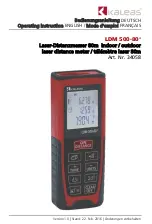
11
Section 1: AccuLase-GPA™
1.1
Overview
The Galvanic Applied Sciences AccuLase-GPA™ uses Tunable Diode Laser Absorption Spectroscopy (TDLAS)
to determine the concentration of a target gas species (hydrogen sulfide, H
2
S) in a variety of gaseous
process streams.
1.2
Principle of Operation
The AccuLase-GPA™ is based on TDLAS in the near-infrared part of the electromagnetic spectrum,
combined with the use of a Herriott Cell to provide an optical path length of over 50 metres in a compact
package. Near-infrared TDLAS sensors provide fast, high-sensitivity measurement of a selected gas or
gases in complex sample gas mixtures. As with any optical absorption-based instrument, the
concentration of the target gas species can be determined by measuring the absorbance at a specific
wavelength characteristic of the target gas species. Molecules of the target gas absorb laser light at
frequencies corresponding to rotation, stretch, and bend vibrational modes for those molecules. The
relationship between the absorbance and is given by the Beer-Lambert Law, shown below:
𝐴𝐴
=
𝜀𝜀𝜀𝜀𝜀𝜀
Where:
A = Absorbance
ε
= molar absorptivity of the target gas
C = concentration of the target gas
l = optical path length
The specific wavelength at which the absorbance is measured is chosen to reduce interference from other
gaseous species in the gas mixture being analyzed to the greatest extent possible. The specific wavelength
of light emitted by the laser can be controlled by adjusting the current and / or the temperature of the
laser emitter. In order to improve the sensitivity of the analyzer, a detector signal processing method
known as Wavelength Modulation Spectroscopy is used. This method rejects noise and thus increases the
signal-to-noise ratio, allowing a much lower detectable limit for the target gas species than would
otherwise be possible.
1.3
Features of the Analyzer
The AccuLase-GPA™ provides the following capabilities:
•
The ability to measure the concentration of hydrogen sulfide gas over a 0-500ppm range with
exceptional linearity and repeatability
•
The ability to measure as many as 4 sample streams on a single analyzer
•
Sensitivity down to 0.15ppm for Hydrogen Sulfide
•
Rapid response within 30 seconds including sample conditioning
•
No consumables other than calibration standard gas
•
Very low maintenance and low cost of operation
•
Ethernet communication for local and remote operation via a web-based GUI
•
Built-in Data Logging
•
Modbus communication via either RS232 or RS485












































